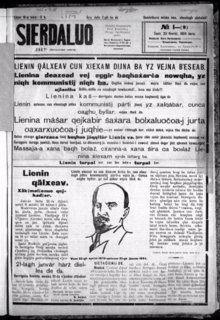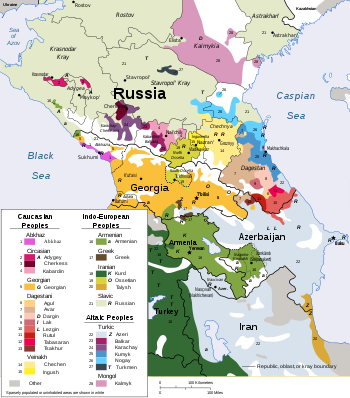Ingush language
Ingush (/ˈɪŋɡʊʃ/; ГӀалгӀай мотт, Ghalghaj mott, pronounced [ʁəlʁɑj mot]) is a Northeast Caucasian language spoken by about 500,000 people, known as the Ingush, across a region covering the Russian republics of Ingushetia and Chechnya.
| Ingush | |
|---|---|
| гӀалгӀай мотт (ghalghaj mott) | |
| Pronunciation | [ʁəlʁɑj mot] |
| Native to | Russia, Kazakhstan |
| Region | Ingushetia, Chechnya |
| Ethnicity | Ingush |
Native speakers | 306,000 (1999–2010)[1] |
| Official status | |
Official language in | |
| Language codes | |
| ISO 639-2 | inh |
| ISO 639-3 | inh |
| Glottolog | ingu1240[2] |

Classification
Ingush and Chechen, together with Bats, constitute the Nakh branch of the Northeast Caucasian language family. There is pervasive passive bilingualism between Ingush and Chechen.[3]
Geographic distribution
Ingush is spoken by about 413,000 people (2002),[4] primarily across a region in the Caucasus covering parts of Russia, primarily Ingushetia and Chechnya. Speakers can also be found in Kazakhstan, Uzbekistan, Turkmenistan, Belgium, Norway, Turkey and Jordan.
Official status
Ingush is, alongside Russian, an official language of Ingushetia, a federal subject of Russia.
Writing system
Ingush became a written language with an Arabic-based writing system at the beginning of the 20th century. After the October Revolution it first used a Latin alphabet, which was later replaced by Cyrillic.
| А а | Аь аь | Б б | В в | Г г | ГӀ гӀ | Д д | Е е |
| Ё ё | Ж ж | З з | И и | Й й | К к | Кх кх | Къ къ |
| КӀ кӀ | Л л | М м | Н н | О о | П п | ПӀ пӀ | Р р |
| С с | Т т | ТӀ тӀ | У у | Ф ф | Х х | Хь хь | ХӀ хӀ |
| Ц ц | ЦӀ цӀ | Ч ч | ЧӀ чӀ | Ш ш | Щ щ | Ъ ъ | Ы ы |
| Ь ь | Э э | Ю ю | Я я | Яь яь | Ӏ |
Phonology
Vowels
| Front | Central | Back | |
|---|---|---|---|
| High | и [i] | у [u] | |
| Mid | э [e] | ? [ə] | о [o] |
| Low | аь [æ] | а [ɑː, ɑ] |
The diphthongs are иэ /ie/, уо /uo/, оа /oɑ/, ий /ij/, эи /ei/, ои /oi/, уи /ui/, ов /ow/, ув /uw/.
Consonants
The consonants of Ingush are as follows,[5] including the Latin orthography developed by Johanna Nichols:
| Labial | Alveolar | Postalveolar | Palatal | Velar | Uvular | Epiglottal | Glottal | ||||
|---|---|---|---|---|---|---|---|---|---|---|---|
| central | lateral | palatalized | plain | ||||||||
| Nasal | м m [m] | н n [n] | |||||||||
| Plosive | voiceless | п p [p] | т t [t] | к kj [kʲ] | к k [k] | кх q [q] | Ӏ w [ʡ] | ъ ʼ [ʔ] | |||
| voiced | б b [b] | д d [d] | г gj [ɡʲ] | г g [ɡ] | |||||||
| ejective | пӀ pʼ [pʼ] | тӀ tʼ [tʼ] | кӀ kjʼ [kʲʼ] | кӀ kʼ [kʼ] | къ qʼ [qʼ] | ||||||
| Affricate | voiceless | ц c [t͡s] | ч ch [t͡ʃ] | ||||||||
| ejective | цӀ cʼ [t͡sʼ] | чӀ chʼ [t͡ʃʼ] | |||||||||
| Fricative | voiceless | ф f [f] | с s [s] | ш sh [ʃ] | х x[χ] | хь hw [ʜ] | хӀ h [h] | ||||
| voiced | в v [v]/[w] | з z [z] | ж zh [ʒ] | гӀ gh [ʁ] | |||||||
| Approximant | л l [l] | й j [j] | |||||||||
| Trill | voiceless | рхӀ rh [r̥] | |||||||||
| voiced | р r [r] | ||||||||||
Dialects
Ingush is not divided into dialects with the exception of Galain-Ch'azh (native name: Галайн-ЧӀаж), which is considered to be transitional between Chechen and Ingush.
Grammar
Ingush is a nominative–accusative language in its syntax, though it has ergative morphology.[6]
Case
The most recent and in-depth analysis of the language[7] shows eight cases: nominative, ergative, genitive, dative, allative, instrumental, lative, and comparative.
| Cases | Singular | Plural |
|---|---|---|
| Nominative | -⌀ | -azh / -ii, -i3 |
| Ergative | -uo / -z, -aa1 | -asha / –azh |
| Genitive | -a, -n2 | -ii, -i |
| Dative | -na, aa2 | -azh-ta |
| Allative | -ga | -azh-ka |
| Instrumental | -ca | -azh-ca |
| Lative | -gh | -egh |
| Comparative | -l | -el |
- -uo is the only productive form. -z appears with personal names, kin terms, and other nouns referring to humans. -aa occurs with some declensions and is increasingly productive in colloquial use.
- Allomorph after vowels
- The choice of -azh vs. -ii is lexically determined for the nominative, but other cases are predictable.
Tenses[8]
| Stem | Suffix | Tense | Example |
|---|---|---|---|
| Infinitive Stem | {-a} | Infinitive (INF) | laaca |
| (INFS) | {-a} | Imperative (IMP) | laaca |
| Present Stem | --- | Generic Present (PRES) | loac |
| (unmarked) | {-az&} | Simultaneous Converb (SCV) | loacaz& |
| {-ar} | Imperfect (IMPF) | loacar | |
| {-agDa} | FUTURE (FUT) | loacadda | |
| Past Stem | {-ar} | Witnessed Past (WIT) | leacar |
| (PAST) | {-aa}/{-na} | Anterior Converb (ACV) | leacaa |
| {-aa} + {-D} / {-na} + {-D} | Perfect (PERF) | leacaad | |
| {-aa} + {-Dar} / {-na} + {-Dar} | Pluperfect (PLUP) | leacaadar |
Numerals
Like many Northeast Caucasian languages, Ingush uses a vigesimal system, where numbers lower than twenty are counted as in a base-ten system, but higher decads are base-twenty.
| Orthography | Phonetic | Value | Composition |
|---|---|---|---|
| cwa | [t͡sʕʌ] | 1 | |
| shi | [ʃɪ] | 2 | |
| qo | [qo] | 3 | |
| d.i'1 | [dɪʔ] | 4 | |
| pxi | [pxɪ] | 5 | |
| jaalx | [jalx] | 6 | |
| vorh | [vʷor̥] | 7 | |
| baarh | [bar̥] | 8 | |
| iis | [is] | 9 | |
| itt | [itː] | 10 | |
| cwaitt | [t͡sʕɛtː] | 11 | 1+10 |
| shiitt | [ʃitː] | 12 | 2+10 |
| qoitt | [qoitː] | 13 | 3+10 |
| d.iitt1 | [ditː] | 14 | 4+10 |
| pxiitt | [pxitː] | 15 | 5+10 |
| jalxett | [jʌlxɛtː] | 16 | 6+10 |
| vuriit | [vʷʊritː] | 17 | 7+10 |
| bareitt | [bʌreitː] | 18 | 8+10 |
| tq'iesta | [tqʼiːestə̆] | 19 | |
| tq'o | [tqʼo] | 20 | |
| tq'ea itt | [tqʼɛ̯æjitː] | 30 | 20+10 |
| shouztq'a | [ʃouztqʼə̆] | 40 | 2×20 |
| shouztq'aj itt | [ʃouztqʼetː] | 50 | 2×20+10 |
| bwea | [bʕɛ̯æ] | 100 | |
| shi bwea | [ʃɪ bʕɛ̯æ] | 200 | 2×100 |
| ezar | [ɛzər] | 1000 | loan from Persian |
- Note that "four" and its derivatives begin with noun-class marker. d- is merely the default value.
Pronouns
| 1sg | 1plexcl | 1plincl | 2sg | 2pl | 3sg | 3pl | |
|---|---|---|---|---|---|---|---|
| Nom. | so | txo | vai | hwo | sho/shu | yz | yzh |
| Gen. | sy | txy | vai | hwa | shyn | cyn/cun | caar |
| Dat. | suona | txuona | vaina | hwuona | shoana | cynna | caana |
| Erg. | aaz | oaxa | vai | wa | oasha | cuo | caar |
| All. | suoga | txuoga | vaiga | hwuoga | shuoga | cynga | caarga |
| Abl. | suogara | txuogara | vaigara | hwuogara | shuogara | cyngara | caargara |
| Instr. | suoca(a) | txuoca(a) | vaica(a) | hwuoca | shuoca(a) | cynca | caarca(a) |
| Lat. | sogh | txogh | vaigh | hwogh | shogh | cogh | caaregh |
| Csn. | sol | txol | vail | hwol | shol | cul/cyl | caarel |
Word order
In Ingush, "for main clauses, other than episode-initial and other all-new ones, verb-second order is most common. The verb, or the finite part of a compound verb or analytic tense form (i.e. the light verb or the auxiliary), follows the first word or phrase in the clause".[9]
- muusaa vy hwuona telefon jettazh
- Musa V.PROG 2sg.DAT telephone striking
- 'Musa is telephoning you.'
References
- "Ingush". Ethnologue. Retrieved 2018-05-08.
- Hammarström, Harald; Forkel, Robert; Haspelmath, Martin, eds. (2017). "Ingush". Glottolog 3.0. Jena, Germany: Max Planck Institute for the Science of Human History.
- Johanna Nichols, Ronald L. Sprouse, Ingush-English and English-Ingush dictionary. p 1
- Ethnologue report for Ingush
- Johanna Nichols, Ingush Grammar (Berkeley: University of California Press, 2011) ISBN 978-0-520-09877-0.
- Johanna Nichols, Case in Ingush Syntax, and Johanna Nichols,Ingush Grammar (Berkeley: University of California Press, 2010). ISBN 0-520-09877-3.
- Johanna Nichols, Ingush Grammar.
- Zev Handel, Ingush inflectional verb morphology: a synchronic classification and historical analysis with comparison to Chechen http://faculty.washington.edu/zhandel/Handel_Ingush.pdf.
- Nichols, Johanna. (2011). Ingush Grammar. Berkeley: The University of California Press. Pp. 678ff.
External links
| Ingush edition of Wikipedia, the free encyclopedia |
- Appendix:Cyrillic script
- Indigenous Language of the Caucasus (Ingush)
- Ingush Language Project at UC Berkeley
- University of Graz report
- Russian-Ghalghaj (Ingush) vocabulary
- Ingush 100-word Swadesh list at the Global Lexicostatistical Database
